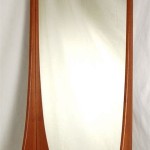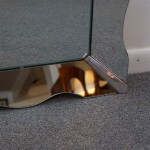How To Take Mirror Tiles Off a Wall
Removing mirror tiles from a wall can seem daunting, but with the right tools and techniques, it can be a manageable DIY project. This article outlines a safe and effective method for removing mirror tiles, minimizing damage to the underlying wall.
Preparing the Work Area
Preparation is crucial for a smooth removal process. Begin by covering the floor beneath the tiled area with drop cloths or heavy-duty plastic sheeting. This protects the floor from falling shards of glass and adhesive residue. Secure the covering with painter's tape to prevent slippage. Next, apply painter's tape to the edges of adjacent walls or cabinets to safeguard them from accidental scratches or damage during the removal process. Put on safety glasses and work gloves to protect from glass fragments and sharp edges.
Loosening the Adhesive
Mirror tiles are often adhered with strong adhesives, requiring careful loosening techniques. A heat gun or hairdryer can soften the adhesive, making the tiles easier to pry off. Applying heat directly to the tile's surface for a short period helps weaken the adhesive bond. A putty knife or a thin, flexible blade can be carefully inserted between the tile and the wall. Gently wiggle the tool to create a small gap. Avoid excessive force, which could crack the tile. Repeating this heating and prying process along the edges of the tile gradually loosens its grip on the wall.
Removing the Tiles
Once the adhesive is sufficiently softened, a putty knife or a specialized tile remover tool can be used to pry the tiles away from the wall. Start at a corner or edge and work inwards. Applying steady, even pressure minimizes the risk of shattering. As each tile is removed, carefully inspect the wall for any remaining adhesive residue. A scraper or putty knife can be used to remove stubborn pieces of adhesive, prepping the wall for future finishes. If the wall is drywall and shows some damage around the edges, make the necessary repairs with joint compound and wait for it to dry completely for any follow-up work.
Dealing with Stubborn Tiles
Some tiles may prove more difficult to remove than others due to stronger adhesive or uneven surfaces. For these stubborn tiles, a hammer and chisel can be employed. A small chisel can be carefully placed at the edge of the tile, and gentle taps with a hammer can help break the adhesive bond. Exercise extreme caution with this method to avoid damaging the underlying wall. If the adhesive is particularly strong, a commercial adhesive remover can be applied to further weaken the bond before attempting removal.
Cleaning the Wall Surface
After all tiles are removed, the wall surface will likely have adhesive residue. A scraper can remove larger pieces of adhesive. For remaining residue, a solvent specifically designed for adhesive removal can be applied according to the manufacturer's instructions. Always test the solvent on an inconspicuous area first to ensure it doesn't damage the wall's finish. After the adhesive is removed, clean the wall with a suitable cleaning solution to prepare it for repainting or other surface treatments.
Alternative Removal Methods
For larger mirror tile installations, or if the tiles are particularly difficult to remove, consider using a reciprocating saw with a specialized grout removal blade. This method can speed up the removal process, but requires careful handling to prevent damage to the wall. Score the grout lines with a utility knife before using the saw to create a cleaner cut and minimize vibrations. Always wear safety glasses and a dust mask when using power tools.
Safety Considerations Throughout the Process
Safety should be a primary concern throughout the entire removal process. Always wear appropriate safety gear, including safety glasses, work gloves, and a dust mask, especially when dealing with broken tiles or using power tools. Dispose of broken tiles and debris carefully in heavy-duty garbage bags to prevent injuries. Adequate ventilation is also crucial when using adhesive removers or other chemicals. Keep the area well-ventilated to prevent the buildup of fumes.
Repairing Minor Wall Damage
Minor wall damage is common during tile removal, particularly on drywall surfaces. Small holes or gouges can be easily repaired with spackling compound. Apply the compound to the damaged areas using a putty knife, smoothing it out evenly with the surrounding wall surface. Allow the compound to dry completely according to the manufacturer's instructions, then sand it smooth for a seamless finish. Prime the repaired areas before painting or applying any other wall covering to ensure a uniform appearance.

How To Remove A Mirror Glued The Wall Forbes Home

How To Remove Mirrored Wall Tiles Domesblissity

How To Remove A Wall Mirror 11 Steps With Pictures Wikihow

How To Remove Mirrored Wall Tiles Domesblissity

How To Remove A Wall Mirror 11 Steps With Pictures Wikihow

Mirror On The Wall

12pcs Mirror Tiles Frameless Wall Mounted Square Make Up For Vanity Bedroom Com

Set Of 3 Clear Square Frameless Wall Mirror Tiles 400 X Mm Diy At B Q

Glass Mirror Tiles Wall Sticker Square Self Adhesive Stick On Art Diy Home Us Com

Living Room Wall Decor Ideas Accent Mirror Glass Panels Tiles Inte Tile Design








